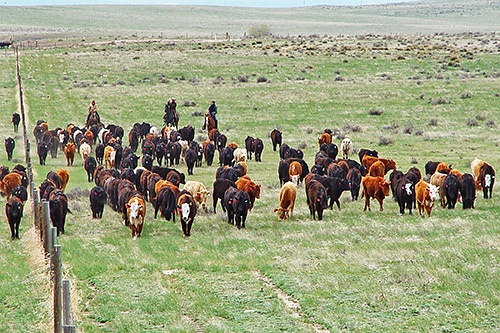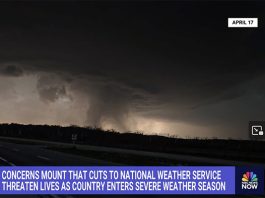

Rotational or continuous grazing? Which system allows for more sustainable and profitable free-range livestock production?
Ranchers often rotate cattle seasonally among different pastures on their operations but may allow cattle to graze season-long in a single pasture. Implementing a more intensive rotational system within the growing season—dividing the pasture into smaller areas, or paddocks, and shifting a herd of animals throughout the season—has been suggested to offer a greater chance for more sustainable grazing management. However, there have been very few experimental studies testing these ideas in extensive grazing systems.
A team of researchers at the USDA’s Agricultural Research Service is completing a 10-year study on how grazing practices used in these two systems affect cattle foraging behavior, diet quality, and yearly weight gain in semi-arid, extensive rangelands.
Tracking Collars Provide Detailed Foraging Information
The team started by exploring the efficiency of using cattle global positioning system (GPS) tracking collars, combined with activity sensors, to monitor the animals’ grazing activities.
“The primary objective of the study was using the sensors to measure the steers’ foraging behavior, and relate this to how they are gaining weight,” said David Augustine, a research ecologist with the ARS Rangeland Resources & Systems Research in Colorado.
The collars collected precise data based on the animals’ feeding habits per day, such as how much time was spent grazing every day, how many steps were taken (grazing speed), the shape of the foraging pathways, and how long each animal lowered their head as a sign of eating (representing the length of meals).
Even though the accuracy of the application is still being refined, results showed that the technology can inform livestock managers about animal distribution and foraging behaviors of free-ranging cattle in extensive rangelands. Being able to monitor foraging behavior continuously in turn allows managers to make more timely decisions on how, when, and where to move cattle within their operation, or to sell cattle at optimal times.
The researchers then applied the same technology in a range-scale experiment where steers were either divided into smaller herds in the paddocks of a non-rotational (season-long) grazing system or managed as a single large herd in a multi-paddock rotational system (using a collaborative and adaptive rangeland management approach).
Foraging Behavior Explains Why Season-Long Grazing Results in 14% Higher Weight Gains
The first five years of data showed that the rotationally managed cattle gained, on average, 14 percent less weight than cattle in the season-long management system.
“Cattle did not have as much freedom to roam and be more selective on what to eat, so they ended up eating what was available in front of them, which was lower quality forages with less protein, and they gained less weight as a result. These behaviors were directly correlated to the average of 14 percent reduction in steer weight gain in the multi-paddock rotating system compared to the non-rotational continuous system,” explained Augustine.
 The study showed herds in the multi-paddock rotating system feeding in more linear pathways instead of moving around looking for greener grass and selecting bites of more digestible vegetation. They also fed slower, spent more time on the same patch of grass, and didn’t turn their heads around much while feeding, compared with steers in the continuous grazing system. These behaviors of less selective foraging resulted in a lower diet quality, which led to reduced weight gain during the growing season.
The study showed herds in the multi-paddock rotating system feeding in more linear pathways instead of moving around looking for greener grass and selecting bites of more digestible vegetation. They also fed slower, spent more time on the same patch of grass, and didn’t turn their heads around much while feeding, compared with steers in the continuous grazing system. These behaviors of less selective foraging resulted in a lower diet quality, which led to reduced weight gain during the growing season.
Results, published in Agriculture, Ecosystems, and Environment, show that large herds grazing in small, homogenous paddocks have little opportunity to move around in ways that let them feed on high quality diet.
The collaborative experiment was conducted at the Central Plains Experimental Range, an ARS Long-term agroecosystem research network site in Colorado.
Augustine and coauthors Sean P. Kearney, Edward J. Raynor, Lauren M. Porensky, and Justin D. Derner, hope this study can help better understand cattle foraging behavior and assist rangeland managers in selecting grazing practices between a traditional continuous system versus a collaborative multi-rotational system.
More…
On Pasture has covered other research results on this topic by this team of researchers. You can read those articles here:
Adaptive, Multi-Paddock Grazing May Not Be Better Than Continuous Grazing
The Agricultural Research Service is the U.S. Department of Agriculture’s chief scientific in-house research agency. Daily, ARS focuses on solutions to agricultural problems affecting America. Each dollar invested in U.S. agricultural research results in $20 of economic impact.
P.S. I’m leaving the comments open so you can discuss amongst yourselves, but I won’t be weighing in. I’m still retired and this week I’m heading out to do some really fun things. 🙂




It’s been my assumption for some time that rotational grazing may not improve gain, as your results show. But does the carrying capacity increase enough with rotational grazing to offset and beat the 14 percent gain deficit?
As the paper notes, grass production was very similar under both types of grazing management. At the same time, it’s important to remember that this research is for the shortgrass prairie which has a different climate so grasses grow differently.
Good article talking about weight gain. My questions are: Which system grew more forage in a given year? Which one was more profitable per acre? Which system produced more pounds per acre? Crop farmers measure their production on a per acre basis. Why as a cattle or sheep or goat producer would I not do the same?
If you follow the link to the paper you’ll find the answer to your question under “snippets.” I’ve cut and pasted it below:
Forage and cattle production
Total forage production was similar across the two sets of treatment paddocks for all years of the study (Treatment x Year interaction: F3,232 = 1.58, P = 0.20; Treatment main effect: F1,97.3 = 0.73, P = 0.39; Fig. 3). In contrast to the forage production results, and as previously reported by Augustine et al. (2020), cattle growth rates (kg/animal/day) were reduced by an average of 14.1% in CARM vs. TRM across the five treatment years, with no significant variation in the magnitude of this…
If forage production is similar but rotational grazing results in lower weight gains, you can see the effect on profitability.
Comments are closed.